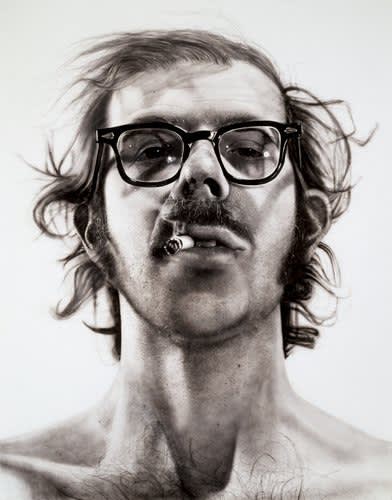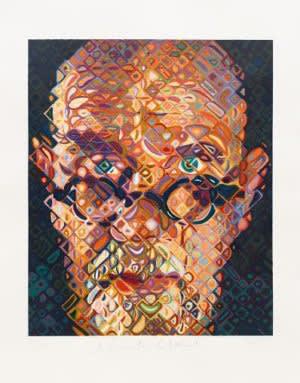Chuck Close died on Thursday, August 19 at a hospital in Oceanside, New York at the age of 81. The cause of death was heart failure.
His large, photorealist portraits of himself and friends made him one of the most recognizable artists of our time.
Born in Monroe, Washington in 1940, Close developed an interest in art at a young age. He was dyslexic, and was a poor student all the way through high school. Despite his poor performance, Close managed to complete his B.A. at the University of Washington in Seattle and win a scholarship to Yale, from where he received his M.F.A. He then went on to the Academy of Fine Arts in Vienna on a Fulbright grant.
After teaching art at the University of Massachusetts, he moved to New York and began to pursue his career as a full time artist. It was a time when Abstract Expressionism and Pop Art were the major movements of the day, but Close chose to do figurative and portrait works in grid fashion.
One of the interesting thing about his choosing portraiture as a subject, was that he had a condition called prosopagnosia, or face blindness, which rendered him unable to recognize faces. Working from photographs, in a grid, Close was able to recreate the his portraits from the photos. This led to his becoming an adept photographer, printmaker and even tapestry artist.
The Walker Art Center in Minneapolis bought Big Self-Portrait in 1969. It was the first painting that Close sold, and his career took off. His works are included in the permanent collections of the Museum of Modern Art in New York, the National Gallery of Art in Washington, D.C. and many other major venues around the world, with his paintings, photographs and tapestries garnering seven figures at auction.
In 1988, after giving a speech at a ceremony honoring him and other New York artists, Close suffered chest pains and walked across the street to Beth Israel Medical Center, where he had a seizure, was diagnosed with spinal artery collapse, that left him paralyzed from the waist down. He went through many months of physical rehabilitation and was determined to resume painting.
With the help of studio assistants, Close was able to paint by using Velcro to strap a brush to his wrist. “My entire life is held together with Velcro,” Close said in a 1998 New York Times interview. Close received the National Medal of Arts in 2000, elected to the National Academy of Design and received more than twenty honorary degrees, including one from Yale University.
In 2013, Close was diagnosed with dementia. In 2017, several women who had modeled in his studio, accused him of inappropriate behavior. The National Gallery of Art in Washington, D.C. indefinitely postponed a planned exhibition.
Close is survived by his daughters, Georgia and Maggie, and four grandchildren.
Please contact us if you would like more information about the works of Chuck Close, available at Surovek Gallery.
References:
Isis Davis-Marks. Chuck Close, Artist Whose Photorealist Portraits Captivated America, Dies at 81. Smithsonian Magazine. August 23, 2021.
Ken Johnson and Robin Pogrebin. Chuck Close, Artist of Outsized Reality, Dies at 81. The New York Times. August 19, 2021. The Guardian. August 20, 2021.
Tim Jonze. Chuck Close, painter of outsized photorealist portraits, dies aged 81. The
Adrian Searle. In your face: how Chuck Close built images and tore them apart. The Guardian. August 20, 2021.
Rain Embuscado. Here Are Chuck Close’s 10 Most Expensive Works at Auction. Artnet News. July 14, 2016.
Jerry Saltz. Chuck Close, Artist Mutineer. Vulture Magazine. August 20, 2021.


![Chuck Close Lucas Paper/Pulp, 2006 [Portrait of the Greek-American artist, Lucas Samaras] Stenciled handmade paper print in Nine colors Paper Size: 48 x 40 inches Edition: 1 of 50 For sale at Surovek Gallery](https://artlogic-res.cloudinary.com/w_600,c_limit,f_auto,fl_lossy,q_auto/ws-artlogicwebsite1323/usr/library/images/main/news/169/lucas-paper-pulp.jpg)

